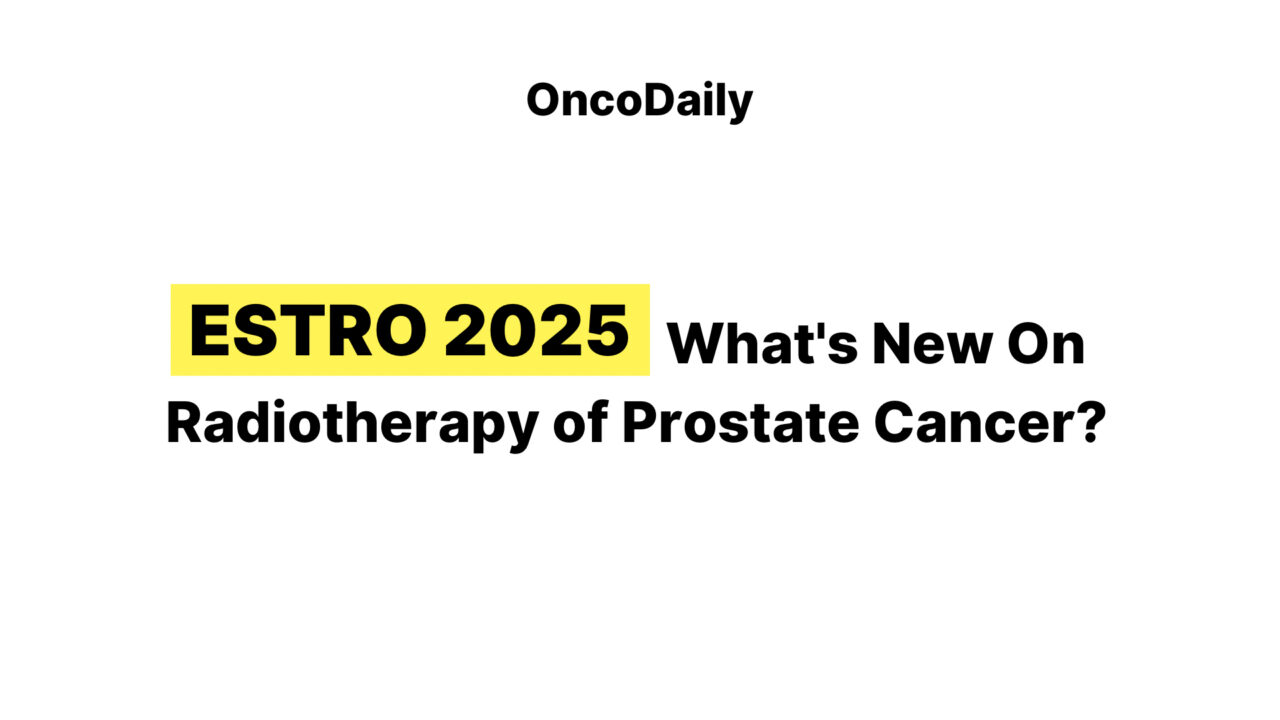
ESTRO 2025: What’s New On Radiotherapy of Prostate Cancer?
Looking back, the European Society for Therapeutic Radiology and Oncology’s (ESTRO) annual congress, ESTRO 2025, held in Vienna, Austria, from May 2nd to May 6th at the Messe Wien Exhibition & Congress Center, remains a recent and significant event. A key gathering for the radiation oncology community, the congress was guided by the central theme, “Transformative Innovation Through Partnership.” This theme underscored the critical role of cross-disciplinary and industry collaboration in driving advancements in radiation oncology and improving cancer care.
Advancements on Radiotherapy of Prostate Cancer at ESTRO 2025
As expected, advancements in radiotherapy for prostate cancer constituted a significant part of the scientific discussions. Recognizing prostate cancer as a major global health challenge, sessions addressing this disease saw high attendance and highlighted new findings.
IMRT vs SBRT
Presented by Poon et al. at ESTRO 2025, a prospective randomized study (SRAM trial) investigated stereotactic body radiotherapy (SBRT) versus fractionated intensity-modulated radiotherapy (IMRT) for treating the prostate and pelvis in men with node-negative high-risk prostate cancer (defined by T3–T4 disease, PSA > 20 ng/mL, and/or Gleason score ≥ 8). The study reported that the weekly 5-fraction SBRT schedule resulted in a similar rate of acute genitourinary toxicities but a significantly lower rate of acute gastrointestinal toxicities compared to IMRT. The findings suggest that this weekly SBRT approach appears safe and favorable regarding acute toxicity profiles for this specific patient group.
SBRT vs HDR-BT For Prostate Cancer
Presented by Andrew Loblaw at ESTRO 2025, an individual patient data meta-analysis of five prospective trials compared stereotactic body radiotherapy (SBRT) and two-fraction high-dose-rate brachytherapy (HDR-BT) in men with intermediate-risk prostate cancer who did not receive androgen deprivation therapy. With a median follow-up of 9.5 years, the study found that SBRT provided significantly better long-term biochemical control, with a substantially lower cumulative incidence of biochemical failure compared to HDR-BT.
Regarding toxicity, HDR-BT was associated with a higher incidence of acute Grade ≥2 genitourinary adverse events, but there were no significant differences in late toxicity or late patient-reported quality of life. The conclusion suggests that two-fraction HDR-BT without ADT for intermediate-risk prostate cancer should be limited to a trial setting based on these results.
Radiotherapy and Sexual Function
Presented by Desai et al. at ESTRO 2025, a prospective trial evaluated neurovascular-sparing SAbR (NV-SAbR) compared to standard SAbR for localized prostate cancer in men with intact sexual function eligible for NV-SAbR with a hydrogel spacer. Early results at 3 months showed no significant difference in acute physician-reported GU/GI toxicities. However, NV-SAbR was associated with significantly better 3-month patient-reported urinary irritative/obstructive quality of life scores and improved (borderline significance) sexual domain scores compared to standard SAbR. The findings suggest that MR/spacer-facilitated NV-SAbR may help mitigate the early quality of life impacts of prostate radiotherapy, particularly concerning urinary function and potentially sexual function, with benefits possibly linked to radiation dose. Longer-term follow-up is planned to confirm these findings.
Presented by Tariq Lalmahomed at ESTRO 2025, the preliminary results from the prospective phase 2 ERECT trial evaluated neurovascular-sparing external beam radiotherapy using an MR-Linac for localized prostate cancer patients with good baseline erectile function. Comparing patients treated with 36.25 Gy in 5 fractions with sparing of erectile structures to a conventional cohort, the study found a significantly reduced incidence of patient-reported erectile dysfunction (ED) and consistently higher preserved erectile function scores (IIEF-5) in the neurovascular-sparing group at 6, 12, and 18 months post-treatment. The findings suggest this approach using MR-Linac can help preserve erectile function, though final 36-month outcomes are pending
Quality of Life Assessment
Presented by Paolo Bonome at ESTRO 2025, a large retrospective study evaluated the impact of radiotherapy (RT) on fatigue in over 1200 prostate cancer patients, most of whom were treated with modern hypofractionated or stereotactic techniques and often received concomitant androgen deprivation therapy (ADT). The study found that the onset of RT-related fatigue, defined as a clinically significant worsening, was reported in a relatively low percentage of patients, less than 15% at one month and less than 20% at 12 months post-RT across various fatigue measures.
Importantly, the analysis identified factors like concomitant ADT, late treatment-related toxicities, and alcohol consumption as significantly associated with an increase in fatigue onset, suggesting that factors beyond the RT technique itself play a significant role in fatigue experienced by these patients.
Radiotherapy And Immunotherapy
Presented by Stephane Supiot at ESTRO 2025, the results of the randomized phase II POSTCARD trial were shared. This study investigated whether adding the immunotherapy agent durvalumab to SBRT would improve outcomes in patients with castration-sensitive oligorecurrent prostate cancer (up to 5 metastases). The primary endpoint, two-year progression-free survival (PFS), was found to be similar between the combination arm (SBRT + durvalumab) and the SBRT-alone arm (23% vs 26%, respectively), indicating that the addition of durvalumab did not improve PFS in this overall patient population.
While the combination arm showed a slight trend towards better ADT-free survival and more frequent very good PSA responses, this did not translate to a significant PFS benefit. The combination did lead to some Grade 3+ immune-related toxicity. The conclusion suggests that while the combination didn’t improve PFS overall, further analysis, such as the exploratory finding regarding circulating tumor cell number, may help identify specific patients who might benefit.

ESTRO 2025 Highlights: Lung Cancer Research. Read our feature!
-
Challenging the Status Quo in Colorectal Cancer 2024
December 6-8, 2024
-
ESMO 2024 Congress
September 13-17, 2024
-
ASCO Annual Meeting
May 30 - June 4, 2024
-
Yvonne Award 2024
May 31, 2024
-
OncoThon 2024, Online
Feb. 15, 2024
-
Global Summit on War & Cancer 2023, Online
Dec. 14-16, 2023
